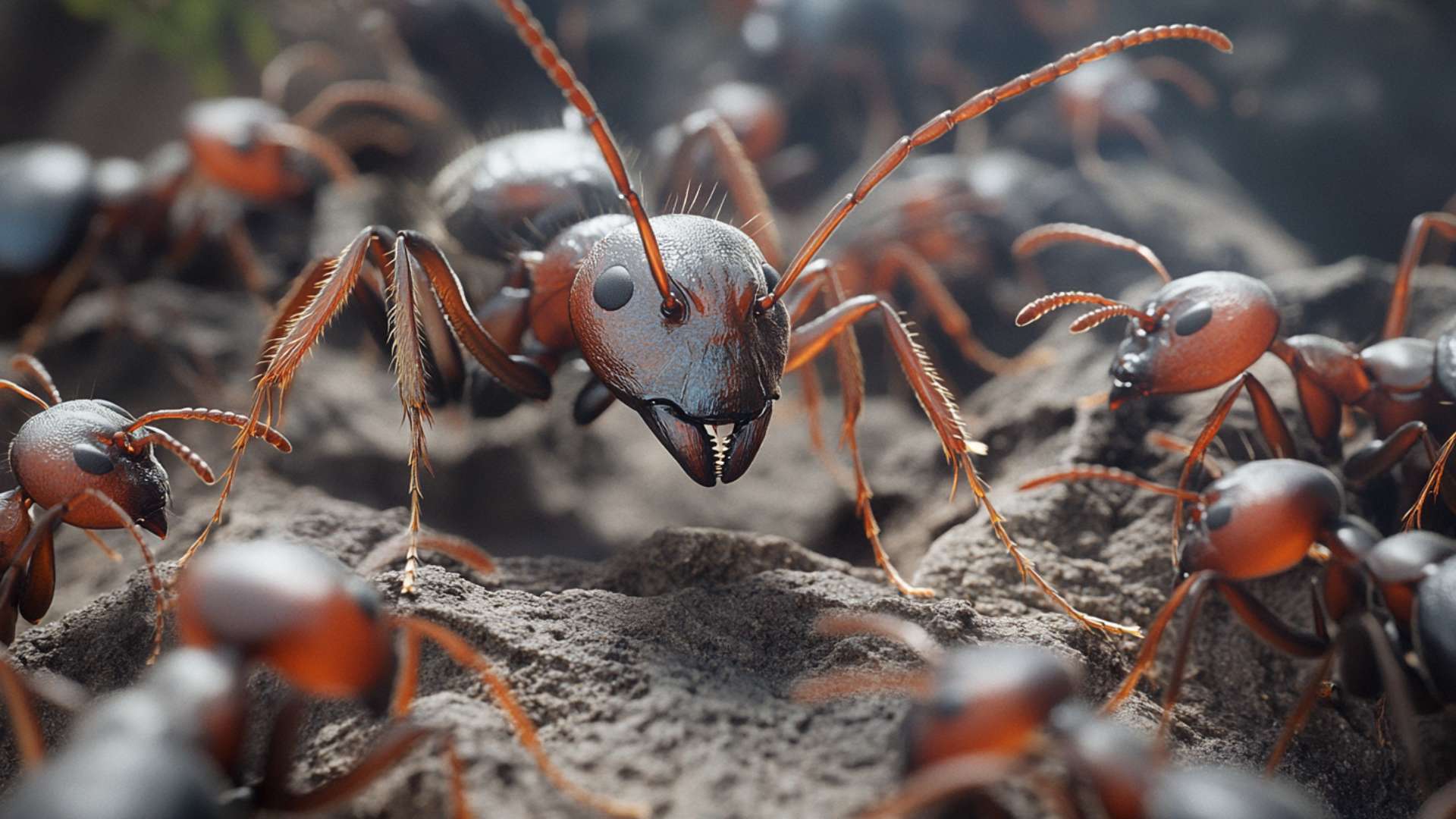Picture this: you’re peacefully enjoying a warm summer day in the comfort of your own home when suddenly, a swarm of flying ants invades your space, disrupting your tranquility and creating a sense of unease. It’s an annoying situation that many homeowners have experienced. These pesky creatures, also known as alates or winged reproductive ants, can be quite bothersome.
They buzz around, often attracted to light sources, and can find their way into your living spaces through tiny cracks and openings. This intrusion can easily ruin any peaceful day indoors.
The Importance of Getting Rid of Them

Now let’s address why it’s crucial to take action against these unwelcome visitors. While flying ants are not inherently dangerous like fire ants that deliver painful bites or termites flying ants that cause structural damage to homes, they can still pose problems if left unattended.
When a colony reaches maturity, it starts producing winged ants that fly out in search of mates during the mating season commonly referred to as “flying ant day.” If these winged ants successfully mate in the air and find suitable locations for new colonies, you may soon find yourself facing an even greater ant infestation problem. Furthermore, having flying ants buzzing around your home is unsettling and disruptive to daily activities.
No one wants to constantly be on edge or have their peaceful moments interrupted by these tiny intruders. Additionally, if you have guests over or are trying to enjoy a meal outdoors on a patio overrun by flying ants, it can quickly become an unpleasant experience.
Ultimately, getting rid of flying ants is essential not only for maintaining peace and cleanliness in your home but also for preventing potential future infestations from turning into larger problems. It is vital to tackle this issue promptly and effectively before it escalates beyond control.
In the following sections of this article, we will delve into the different aspects of dealing with flying ants. We will explore prevention methods, natural remedies, chemical solutions, eradication techniques for specific areas like kitchens and outdoor spaces, pest control specialists as well as professional pest control options.
Additionally, we will provide long-term prevention tips to ensure that you can successfully bid farewell to these bothersome winged intruders. So let’s embark on this journey together and discover how to get rid of flying ants once and for all!
Understanding Flying Ants
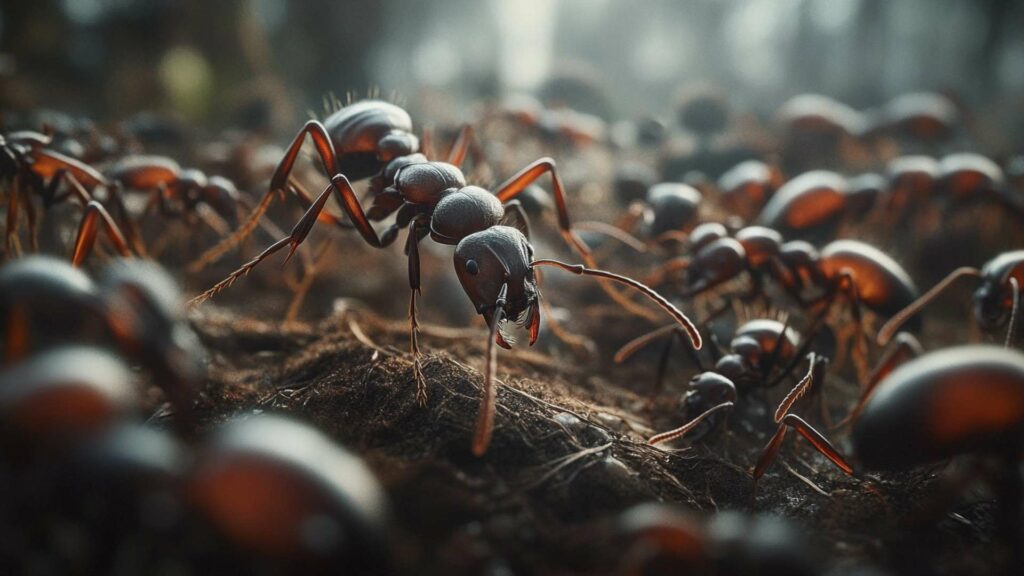
Define flying ants and their lifecycle
Flying ants, scientifically known as alates, are certain ant species that have developed wings and are capable of flight. Unlike how ants fly their crawling counterparts, these winged ants serve a specific purpose in the ant colony’s life cycle. Their primary function is to reproduce and establish new colonies.
The lifecycle of flying ants starts with the emergence of winged male ants and female ants from established nests. The mating process between male ants occurs during what is commonly known as the “nuptial flight.” It is a fascinating spectacle where male and female winged ants gather in large numbers to mate in the air.
After mating, the males perish while females shed their wings to begin searching for suitable nest sites. Once they find an appropriate location, they create a new colony by excavating tunnels underground.
Differentiate between flying ants and termites
It is crucial to differentiate between flying ants and termites since they both have wings during specific stages of their life cycles. Although these two flying insects may appear similar at first glance, there are distinct characteristics that set them apart. One notable difference lies in their wing structure.
Flying ants have noticeable differences in size between their front wings (larger) and hind wings (smaller). In contrast, flying termites have nearly identical-sized wings all around.
Another distinguishing factor is their body shape. Flying ants have a visibly narrow waist separating their thorax from the abdomen, giving them an hourglass-like appearance when viewed from above.
Flying ants bite termites lack this defined waistline as male and female ants generally have a broader waist region. Furthermore, while both insects can cause damage around your home, it’s important to note that termites primarily feed on wood or cellulose material whereas most flying ant species do not pose significant threats to structures.
Understanding these differences will help you identify whether you’re dealing with swarming ants or flying ants bodies other ant characteristics or termites, enabling you to take appropriate action to rid your home of ants effectively. Now that we have a better grasp of what flying ants are and how they differ from termites, let’s move on to identifying their source and taking necessary preventive measures.
Identifying the Source
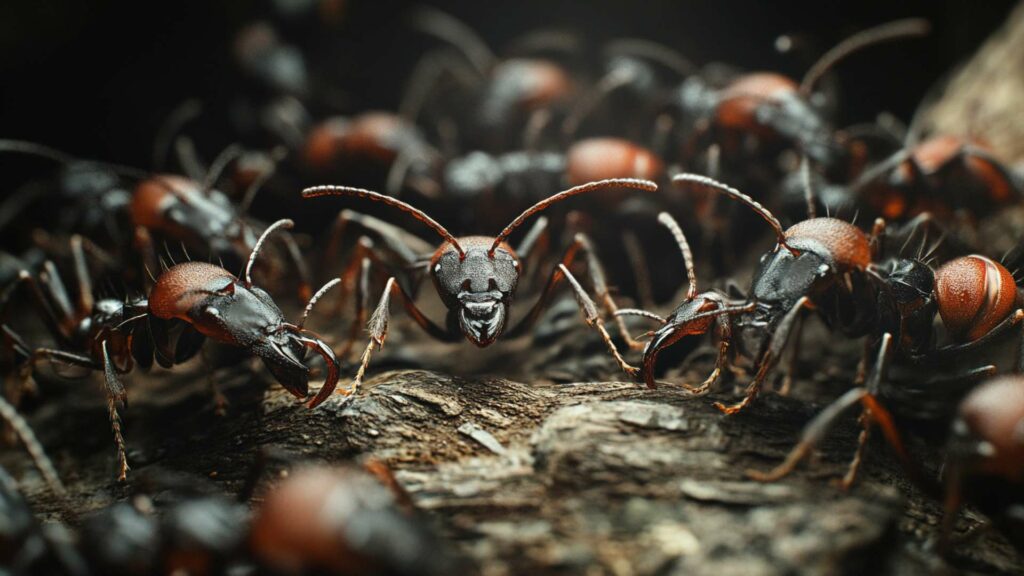
Common Areas Where Flying Ants Nest or Breed
Flying ants, like their non-winged counterparts, prefer to create their nests in areas that provide them with suitable conditions for survival and reproduction. It’s essential to identify these common nesting spots to effectively combat an infestation that attracts flying ants.
One typical area is outdoors near your home, such as in garden beds, under piles of leaves or logs, or even in cracks and crevices of outdoor structures. Additionally, flying ants may establish nests within wall voids or other hidden areas inside your house.
Signs to Look for When Identifying the Source
To pinpoint the source of a flying ant infestation, it’s crucial to be attentive to certain signs that indicate their presence. One telltale sign is spotting swarming flying ants around your home or yard. These swarms often consist of male and queen ants and female winged ants seeking mates and establishing new colonies.
Another observation could be finding discarded termite wings near windowsills or other entry points. Inspecting your property for small piles of wood shavings is also essential as this can suggest a potential termite infestation rather than just flying ants.
Furthermore, if you notice small dirt mounds outdoors with numerous tunnels leading into them, it might indicate a fire ant colony nearby. Examining indoor spaces can be equally important when identifying the source of a flying ant infestation.
Look for any trails of food crumbs or sugary substances that act as attractive food sources for these pests. Additionally, keep an eye out for tiny openings on walls or floors where they may enter from outside.
By understanding where flying ants commonly nest and recognizing the signs they leave behind, you can take appropriate measures to eradicate them from your surroundings effectively.
Prevention Methods
Keeping your home clean and tidy to discourage ant infestation

When it comes to fighting off those pesky flying ants, the first line of defense is cleanliness. These little critters are attracted to food sources and crumbs left behind, so keeping your home clean and tidy is crucial.
Start by regularly sweeping and vacuuming your floors to remove any food debris that might be lurking. Don’t forget those hard-to-reach corners where crumbs tend to hide!
In addition to regular cleaning, it’s essential to store your food properly. Invest in airtight containers for pantry staples like sugar, flour, and cereals.
This will not only keep them fresh but also prevent those winged intruders from sniffing out a feast in your kitchen. Remember, prevention is key when it comes to avoiding an ant problem.
Sealing entry points to prevent their entry into your house
Flying ants are crafty little insects that can find their way into your home through the tiniest cracks and crevices. That’s why sealing these entry points is crucial in preventing their invasion. Inspect both the interior and exterior of your house for any gaps or openings where crawling ants are or where they can sneak in.
Start by checking windows and doors for damaged seals or gaps around the edges. Replace worn-out weatherstripping or use sealant as needed.
Don’t forget about utility openings such as vents or pipes; these should be properly sealed too. For extra protection, consider applying a barrier spray around the perimeter of your home.
This type of insecticide creates a protective shield that prevents flying ants (and other unwanted critters) from crossing over into your living space. By keeping a clean home and sealing potential entry points, you’ll greatly reduce the chances of facing an ant infestation down the line.
Remember, even if you don’t currently have an ant problem, prevention is always better than having to deal with a swarm of flying ants suddenly invading your space!
Natural Remedies for Flying Ants
Using vinegar as a repellent
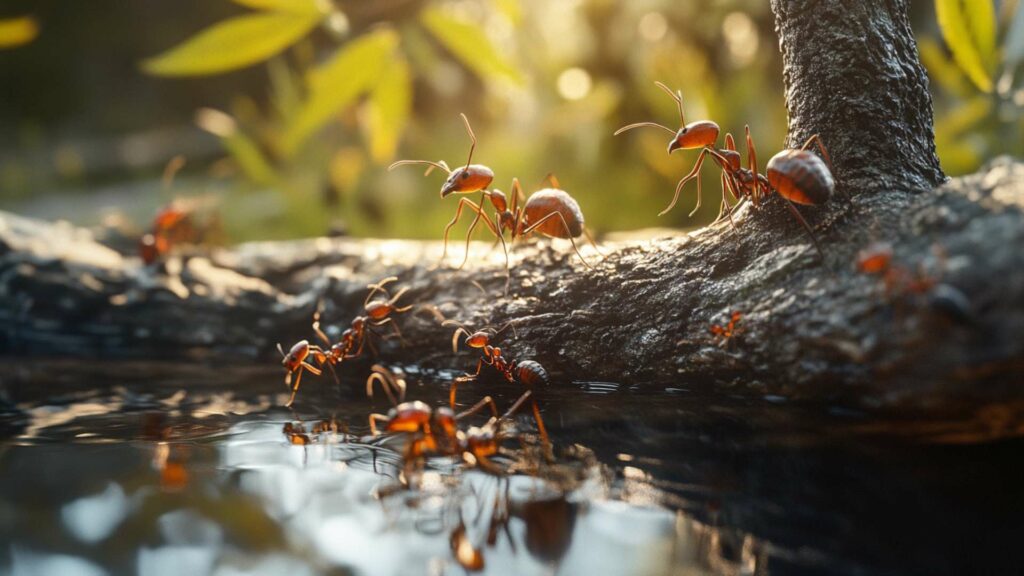
One of the most effective natural remedies for getting rid of flying ants in your home is using vinegar. This pantry staple not only adds flavor to your favorite recipes but also serves as a powerful ant repellent. The strong odor of vinegar disrupts the ants’ pheromone trails, making it difficult for them to communicate and navigate.
To use vinegar as a top insect repellent, mix equal parts vinegar and water in a spray bottle. Spritz this solution around areas where you’ve noticed flying ants or along their entry points.
Pay special attention to windowsills, doorways, and cracks in your walls. The smell will deter them from entering your living space.
Sprinkling cinnamon or peppermint oil around affected areas
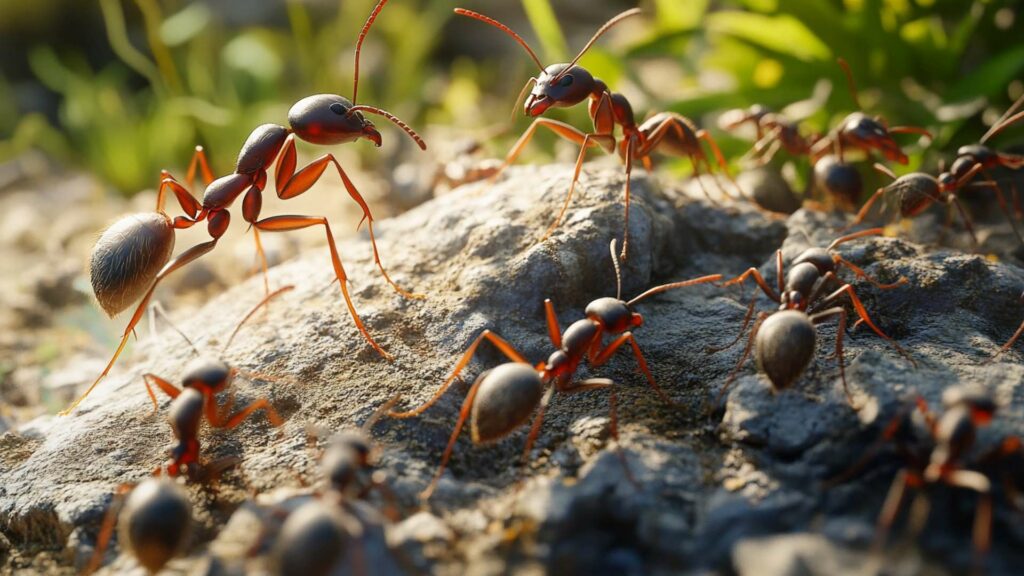
If you’re looking for an aromatic way to fend off those pesky flying ants, cinnamon or peppermint oil can be your go-to options. Both substances are unappealing to ants due to their strong scent and can act as effective deterrents when used strategically.
For cinnamon, sprinkle ground cinnamon around the affected areas such as windowsills or near ant trails. You can also create an aromatic barrier using cotton balls soaked in peppermint oil.
Place these cotton balls near potential entry points or any areas where you have observed ant activity. When using these natural remedies, keep in mind that they may not eliminate the entire ant colony, but rather discourage the insects from venturing further into your home or specific areas.
While natural remedies are useful for dealing with small-scale ant problems, severe infestations may require more aggressive measures such as insecticides or professional pest control intervention. Remember that prevention is key in managing ant infestations effectively!
Chemical Solutions
Overview of Insecticides Specifically Designed for Flying Ants
When it comes to dealing with those pesky flying ants, sometimes you need a little extra help from our chemical friends. Insecticides designed specifically for flying ants are a powerful weapon in the battle against these airborne nuisances.
These potent solutions are formulated to target and eliminate flying ants while minimizing harm to humans and other non-targeted creatures. One popular type of insecticide for flying ants is the spray.
With just a cup of boiling water and a simple push on the nozzle, you can release a mist of chemical goodness that will send those winged invaders running for cover. The spray coats the flying insects’ bodies, effectively suffocating them and disrupting their ability to fly or crawl back to their colony.
Look for insecticide sprays that have specific claims about being effective against flying ants on their label. Another effective option to attract ants is using ant baits.
These irresistible morsels contain a tempting treat laced with insecticide that the worker ants carry back to their colony, effectively wiping out not only the flyers but also their ground-dwelling comrades. It’s like an all-you-can-eat buffet for those sneaky little critters—except this time it’s their last supper.
Powders can also be an excellent choice when dealing with flying ant infestations. Sprinkle these fine particles around areas where you suspect they may be hiding or entering your living space.
As soon as those winged intruders come into contact with the powder, they won’t know what hit ’em! Powders work by dehydrating and damaging the exoskeleton of insects, causing them to dry out and perish.
Exploring Different Types of Insecticides (Sprays, Baits, Powders)
Now let’s dive deeper into various types of insecticides available:
1. Spray Away: Insecticide sprays designed specifically for flying ants are typically available in aerosol cans or as a concentrate that you can dilute and apply using a spray bottle. When using sprays or spray pesticides, make sure to read the instructions carefully and follow them closely. Aim for direct contact with the pesky flyers to effectively get rid of them.
2. Bait ‘Em and Wait ‘Em: Ant baits are an excellent option when dealing with an entire flying ant colony. These little traps contain a tasty treat mixed with insecticide. The worker ants will eagerly carry the bait back to the colony to their nest, unknowingly dooming their comrades in the process. Place these baits strategically near their entry points or areas where you’ve seen high activity.
3. Dust Off with Powder: Powders such as diatomaceous earth are non-toxic to humans but deadly for insects like flying ants. Sprinkle this fine powder around areas where you suspect they may be lurking, like cracks, crevices, and corners of your home. When the unsuspecting flyers come into contact with it, it scratches their exoskeletons, causing dehydration and eventual demise.
Remember, when using any insecticides or chemicals, always prioritize safety by wearing protective clothing and gloves and keeping children and pets away from treated areas. It’s essential to follow the instructions provided by manufacturers to ensure effective use while minimizing risks.
With these chemical solutions at your disposal, those swarming flying ants won’t know what hit them! Just remember that prevention is key to avoiding future infestations; otherwise, you might find yourself facing another aerial assault sooner than expected!
Eradicating Flying Ants from Specific Areas
Getting rid of flying ants in the kitchen
The kitchen is undoubtedly a hot spot for flying ant activity, as it offers abundant sources of food and water.
To combat these persistent pests, it is crucial to keep your kitchen clean and free from any tempting treats that might attract them. Start by cleaning any food spills promptly – wiping down countertops, sweeping floors, and ensuring that crumbs are not left behind.
Pay particular attention to areas near appliances like toasters or dishwashers where crumbs can accumulate unnoticed. Storing food properly is another essential step in getting rid of flying ants in your kitchen.
Invest in airtight containers for pantry staples such as flour, sugar, cereals, and pet food. These containers make it challenging for ants to access their favorite snacks and prevent them from spreading their enticing scent throughout your kitchen.
Eliminating flying ants from outdoor spaces (patios, gardens)
Outdoor spaces like patios and gardens can be prime real estate for flying ant colonies. Taking proactive measures to eliminate these persistent insects will help you enjoy your outdoor oasis without worrying about unwelcome visitors.
Firstly, remove any stagnant water sources around your patio or garden area as they provide ideal breeding grounds for flying ants. Empty water-filled containers like buckets or birdbaths regularly and fix any leaky faucets or pipes that might create standing water.
Additionally, trimming plants near your house can discourage ant populations from taking up residence nearby. Overgrown vegetation provides hiding spots and easy access to buildings for these determined creatures.
By keeping plants well-trimmed and maintaining a tidy garden perimeter, you create an obstacle course that makes it harder for ants to reach your home. Remember, prevention is key when it comes to managing flying ants in these specific areas.
By implementing these simple strategies, you can significantly reduce the chances of encountering a persistent army of winged invaders in your kitchen or outdoor spaces. Note: It’s always important to check local regulations and use environmentally friendly methods to address ant infestations.
Professional Pest Control Options
Outlining scenarios when professional help is necessary
When it comes to dealing with a flying ant infestation, there are situations where it’s best to call in the experts. While there are plenty of DIY methods available, professional pest control companies have the knowledge and experience to tackle more severe or persistent infestations.
Here are a few scenarios where seeking professional help is advisable: 1. Massive Ant Swarms: If you find yourself facing several ant swarms throughout your home, it may indicate a larger underlying problem.
Professional pest control technicians can assess the situation and determine if there is an extensive ant infestation that needs immediate attention. 2. Structural Damage: Flying ants can weaken wooden structures and cause damage over time.
If you notice signs of structural damage or suspect that the ants have established nests within walls or other inaccessible areas, it’s crucial to involve professionals who can effectively locate and eliminate these hidden colonies. 3. Recurring Infestations: Sometimes, despite your best efforts, flying ants keep coming back again and again.
This persistence could indicate that you’re not effectively targeting the root cause of the problem, whether it’s an undiscovered nest or an attractive food source that needs addressing. Pest control experts can identify these underlying factors and implement long-term solutions.
Explaining how pest control experts handle flying ant infestations
When you hire a professional pest control company to handle a flying ant infestation, they follow a systematic approach to ensure effective eradication: 1. Thorough Inspection: The first step for pest control technicians is to conduct a comprehensive inspection of your property to identify key areas where ants are nesting or entering your home.
This includes checking both indoors and outdoors for nests, trails, entry points, and conducive conditions for ant activity. 2. Tailored Treatment Plan: Based on their findings during the inspection, the technicians will develop a customized treatment plan to target the specific needs of your infestation.
This may involve using specific insecticides, baits, or other methods deemed appropriate for flying ant control. 3. Application of Professional-Grade Products: Pest control professionals have access to high-quality pesticides and products that are not readily available to consumers.
They know how to apply these products safely and effectively, ensuring maximum impact on flying ants while minimizing any risks to humans or pets. 4. Follow-Up and Prevention: After the initial treatment, pest control experts will provide guidance on steps you can take to prevent future infestations.
This may include sealing entry points, improving sanitation practices, and maintaining a vigilant eye for signs of reinfestation. By relying on experienced pest control experts, you can enjoy peace of mind knowing that the flying ant infestation is being handled by professionals who understand the behavior and habits of these pests intimately.
Their expertise ensures a higher likelihood of successful eradication and long-term prevention strategies tailored specifically for your situation. Remember, when it comes to dealing with flying ant colonies that have become unmanageable or persistent despite your efforts, reaching out to a professional pest control company is often the best course of action.
Tips for Long-term Prevention
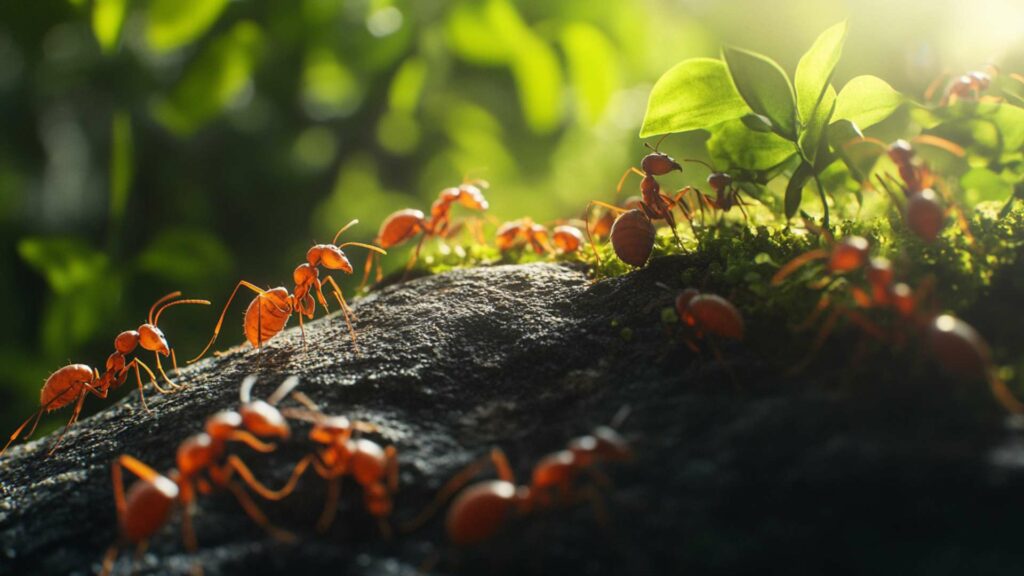
Maintaining cleanliness and hygiene regularly
To effectively prevent flying ants from infesting your home, a crucial step is to maintain cleanliness and hygiene regularly. These pesky insects are attracted to food sources, so ensuring that your kitchen surfaces are clean and free from any food residues is vital.
Be also make sure to promptly clean up spills and crumbs, as even a few drops of leftover juice or bits of food can attract swarms of flying ants in no time. Additionally, pay attention to areas where these insects commonly build their nests.
Keeping your house tidy by decluttering spaces such as basements, attics, and storage areas will discourage ant populations from establishing themselves. Remove any potential hiding spots or debris that could serve as ideal breeding grounds for these pests.
Regularly emptying your garbage bins and properly sealing them can also make a significant difference in deterring ants from entering your home. Ensure that trash bags are tightly closed and consider using bins with lids to prevent flying ants from finding their way inside.
Considering ant-repellent plants in your garden
Another effective way to keep flying ants at bay is by incorporating ant-repellent plants into your garden. Certain plant species naturally emit scents or possess properties that repel these annoying creatures. By strategically placing these plants around areas where flying ants are attracted and frequently enter the house – such as windowsills or door frames – you can create a barrier that discourages their presence.
Some common ant-repellent plants include lavender, peppermint, rosemary, and lemon balm. These plants not only add beauty and fragrance to your garden but also act as natural deterrents against various pests, including flying ants.
Consider planting them near entry points or creating potted arrangements close to windows and doors. In addition to repelling insects like flying ants with their strong aromas, some of these plants are also useful for other purposes.
For instance, peppermint can be harvested and used to make a homemade ant repellent spray by mixing equal parts of water and several drops of peppermint essential oil in half a cup or spray bottle. Spraying this mixture around areas prone to ant activity can help prevent flying ants from making their way into your home.
By maintaining cleanliness and incorporating ant-repellent plants into your garden, you can take proactive measures to prevent flying ants from becoming a nuisance in your home. These simple yet effective strategies will not only help keep your living spaces ant-free but also contribute to overall hygiene and well-being for you and your family.
Conclusion
Addressing the Pesky Intruders: How to Get Rid of Flying Ants Once and for All
As we conclude this comprehensive guide on how to get rid of flying over ants in your home, it is crucial to emphasize the importance of promptly addressing a flying ant infestation. These pesky intruders can quickly multiply and establish new colonies within your home, causing significant damage and ruining your peace of mind.
By understanding the lifecycle of flying ants and differentiating them from their notorious counterparts, flying termites, you have taken a vital step towards effective eradication. Identifying the source of the infestation allows you to target your efforts strategically, preventing further intrusion.
With natural remedies like vinegar repellents or sprinkling cinnamon or even drops of peppermint oil around affected areas, you can create an environment that repels flying ants. Furthermore, chemical solutions such as insecticides offer additional firepower in combating these persistent insects.
Eradicating flying ants from specific areas like kitchens or outdoor spaces requires tailored approaches. Cleaning food spills promptly and storing food properly in the kitchen can deter these unwelcome visitors.
Similarly, eliminating stagnant water sources and trimming plants near your house helps keep outdoor spaces free from swarming flying ants. Remember that professional pest control experts are always available when dealing with severe infestations or if you prefer not to tackle the problem yourself.
Their expertise ensures thorough eradication while minimizing any potential risks associated with pesticides. With a focus on long-term prevention through consistent cleanliness and hygiene practices, as well as considering ant-repellent plants in your garden, you can significantly reduce future encounters with these unwanted guests.
So fear not! Armed with this knowledge on how to get rid of flying ants, you are well-equipped to reclaim your space.
Take action today to get rid of ants and yourself of these nuisances once and for all. Your peaceful sanctuary awaits!
Deter Ants with D-Termination: Las Vegas’ Top Pest Control Provider!
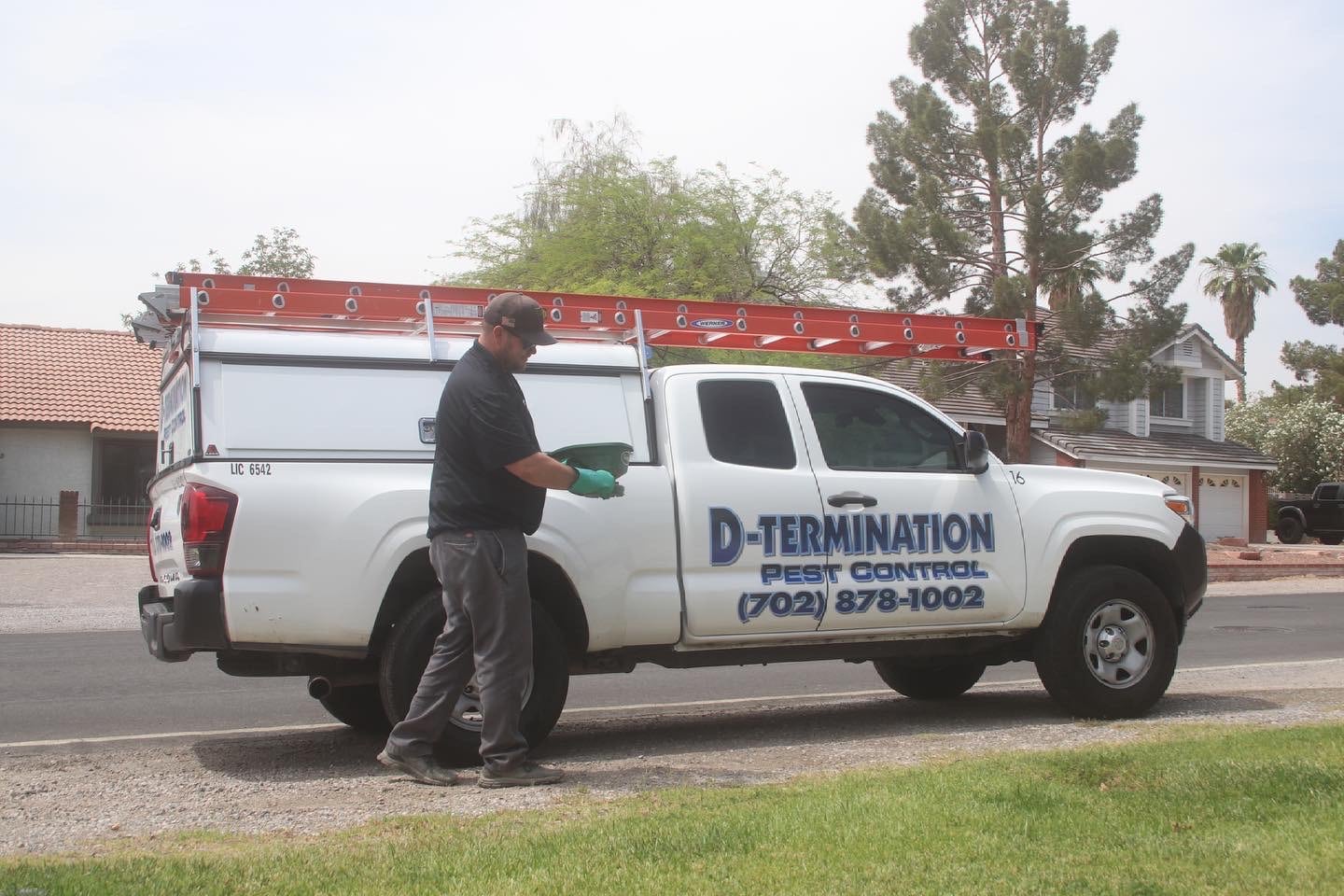
If you’re dealing with ant problems, D-Termination is ready to help. Our skilled team specializes in deterring ants, revitalizing cleanliness, and preserving the integrity of your space. Bid farewell to ants—select D-Termination for highly effective pest control today!
Reach out to us at 702-919-6310 or visit dtermination.com to schedule your ant control service and regain your space from these unwelcome pests.
Frequently Asked Questions:
The fastest way to get rid of flying ants is by using insect spray or traps designed for flying insects.
Sudden appearances of flying ants are often linked to their mating season, which can be triggered by weather conditions.
To get rid of flying ants in your house, use insect sprays, close windows and doors, and eliminate food sources.
To find a flying ant nest, follow their flight path to a point of entry or locate areas with higher ant activity, which may lead to the nest.

